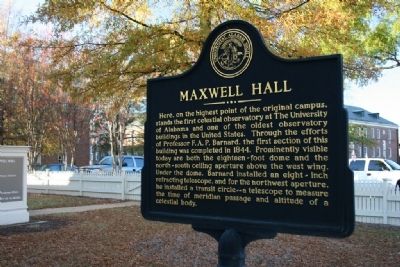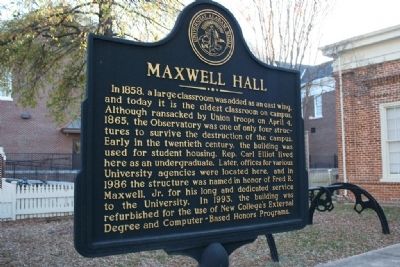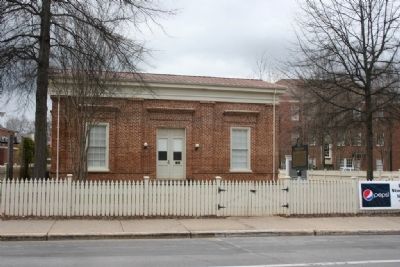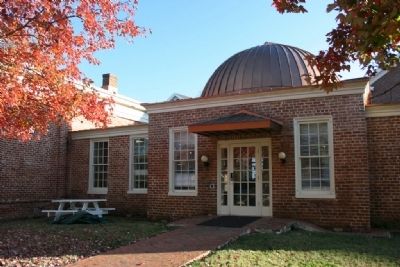Tuscaloosa in Tuscaloosa County, Alabama — The American South (East South Central)
Maxwell Hall
(Reverse):
In 1858, a large classroom was added as an east wing, and today it is the oldest classroom on campus. Although ransacked by Union troops on April 4, 1865, the Observatory was one of only four structures to survive the destruction of the campus. Early in the twentieth century, the building was used for student housing. Rep. Carl Elliot lived here as an undergraduate. Later, offices for various University agencies were located here, and in 1986 the structure was named in honor of Fred R. Maxwell, Jr. for his long and dedicated service to the University. In 1993, the building was refurbished for the use of New College's External Degree and Computer-Based Honors Programs.
Erected by Unversitat. Alabam. SIGILL.
Topics. This historical marker is listed in these topic lists: Education • Science & Medicine • War, US Civil. A significant historical month for this entry is April 1755.
Location. 33° 12.67′ N, 87° 33′ W. Marker is in Tuscaloosa, Alabama, in Tuscaloosa County. Marker is on Stadium Drive north of University Blvd, on the left when traveling north. Building # 2152, Frederick R. Maxwell Hall is located on the Campus of the University of Alabama. Touch for map. Marker is in this post office area: Tuscaloosa AL 35487, United States of America. Touch for directions.
Other nearby markers. At least 8 other markers are within walking distance of this marker. Delta Kappa Epsilon (about 300 feet away, measured in a direct line); Phi Gamma Delta Theta Chapter House (about 400 feet away); Autherine Lucy Foster (about 600 feet away); Morgan Hall, 1910 (about 800 feet away); Gorgas House (approx. 0.2 miles away); Site Of Franklin Hall (approx. 0.2 miles away); Oliver-Barnard Hall (approx. 0.2 miles away); The Little Round House (approx. 0.2 miles away). Touch for a list and map of all markers in Tuscaloosa.
Also see . . . An Antebellum Observatory in Alabama. by Gene Byrd and Robert Mellown of Sky and Telescope. The story about Maxwell Hall is located toward the bottom of this web page. (Submitted on August 24, 2010, by Timothy Carr of Birmingham, Alabama.)
Credits. This page was last revised on June 16, 2016. It was originally submitted on August 24, 2010, by Timothy Carr of Birmingham, Alabama. This page has been viewed 1,282 times since then and 33 times this year. Photos: 1, 2, 3, 4. submitted on August 24, 2010, by Timothy Carr of Birmingham, Alabama. • Craig Swain was the editor who published this page.



